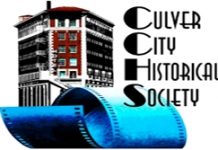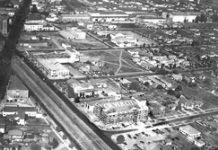This past week’s opening of the Culver City Expo station drew many to Culver City the day of the Summer Solstice. The sidewalks along Washington Building, enjoyed a lot foot traffic. Commissioned by Charles E. Lindblade, its two- year construction began in 1926. Lindblade, a business associate of city founder Harry Culver, engaged master builders Orlopp and Orlopp, who were listed on site in 1927.
The building designer was Arthur D. Scholz, with Orville L. Clark mentioned in old records as the probable consulting architect. Clark went on to design other local buildings, like Culver City’s 1928 City Hall and its adjacent Fire Station #1.
The Washington Building was described in the owner’s application for the National Register of Historic Places, as “Builder’s Beaux Arts Classicism.” The foundation and walls are both reinforced concrete. The areas of significance of the building fell into the categories of Architecture, Commerce and Community Planning and Development. The period of significance was considered to be 1926-1940, with Lindblade listed as the significant figure.
Lindblade(1887-1940), a real estate developer, served both as vice-president and president of Harry Culver’s real estate firm. This building was constructed during Lindblade’s most notable years, professionally, when he and Culver actively developed Culver City. Some of his activities listed in the 1929 Who’s Who in California included service as a director of Security First National Bank of Los Angeles, Pacific Building and Loan Association, (which financed much of the city’s early development), and he also served on the board of the Pacific Military Academy. Lindblade was a founding member of the Culver City Chamber of Commerce, he served as president of the Culver City Realty Board, (1927), and director of the California Real Estate Association (1928-29). He later worked in real estate with Culver’s brother in law, Earl Eastham.
The Washington Building reportedly cost $30,000 to construct. Its triangular shape earned its nickname “The Flatiron Building.” The structure occupies 135 feet of Washington Boulevard frontage, and stretches152 feet along Culver Boulevard. The two long sides converge to a flattened east wall of 12 feet (where Starbucks is today), while the west wall measures 68 feet wide.
In 1931, the Washington Building housed the local post office, until the Gateway Station was completed down the street in 1940. Other notable occupants of the building included the Lindblade Real Estate and Development Company from 1929-1932, the Draft Board during World War II, the MGM Fan Club after the war, a dentist, Dr. Connelly, the American National Insurance Co., a photographer, and attorneys F. A. Berry, Andrew Weissmen in the recent past, while today restaurants are complemented by Lundeens, a busy retail space.
The Washington Building, well cared for by its owner, BYCO, was awarded Landmark status by the City of Culver City in accordance with the C.C.M.C.’s historic preservation ordinance. It is also listed on the National Register of Historic Places, as are Culver City’s Culver Hotel, the Citizen Building and the nearby Ivy Substation.













